warning light CADILLAC ESCALADE EXT 2005 2.G Owner's Manual
[x] Cancel search | Manufacturer: CADILLAC, Model Year: 2005, Model line: ESCALADE EXT, Model: CADILLAC ESCALADE EXT 2005 2.GPages: 460, PDF Size: 2.95 MB
Page 337 of 460
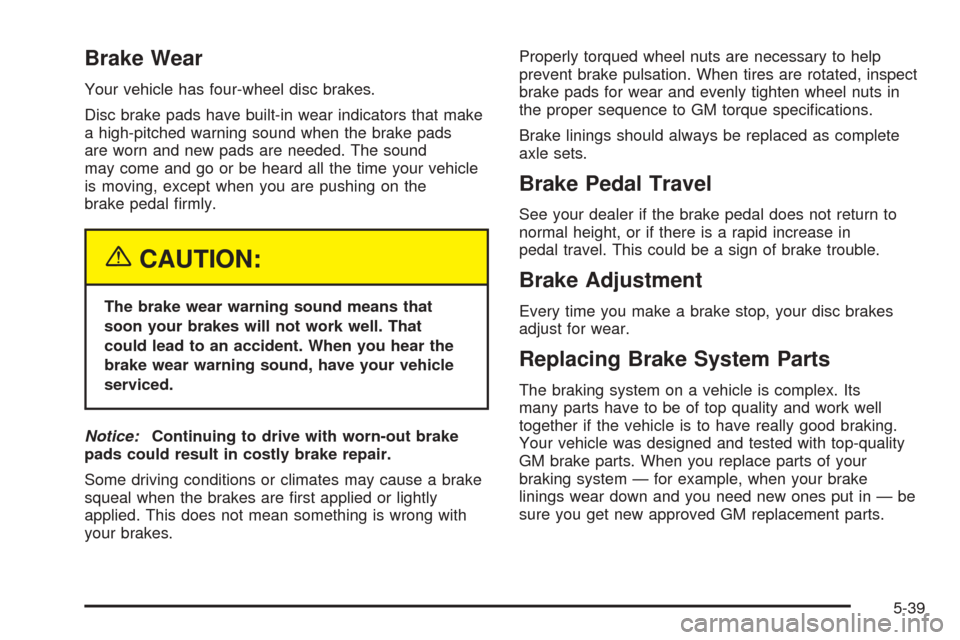
Brake Wear
Your vehicle has four-wheel disc brakes.
Disc brake pads have built-in wear indicators that make
a high-pitched warning sound when the brake pads
are worn and new pads are needed. The sound
may come and go or be heard all the time your vehicle
is moving, except when you are pushing on the
brake pedal �rmly.
{CAUTION:
The brake wear warning sound means that
soon your brakes will not work well. That
could lead to an accident. When you hear the
brake wear warning sound, have your vehicle
serviced.
Notice:Continuing to drive with worn-out brake
pads could result in costly brake repair.
Some driving conditions or climates may cause a brake
squeal when the brakes are �rst applied or lightly
applied. This does not mean something is wrong with
your brakes.Properly torqued wheel nuts are necessary to help
prevent brake pulsation. When tires are rotated, inspect
brake pads for wear and evenly tighten wheel nuts in
the proper sequence to GM torque speci�cations.
Brake linings should always be replaced as complete
axle sets.
Brake Pedal Travel
See your dealer if the brake pedal does not return to
normal height, or if there is a rapid increase in
pedal travel. This could be a sign of brake trouble.
Brake Adjustment
Every time you make a brake stop, your disc brakes
adjust for wear.
Replacing Brake System Parts
The braking system on a vehicle is complex. Its
many parts have to be of top quality and work well
together if the vehicle is to have really good braking.
Your vehicle was designed and tested with top-quality
GM brake parts. When you replace parts of your
braking system — for example, when your brake
linings wear down and you need new ones put in — be
sure you get new approved GM replacement parts.
5-39
Page 366 of 460
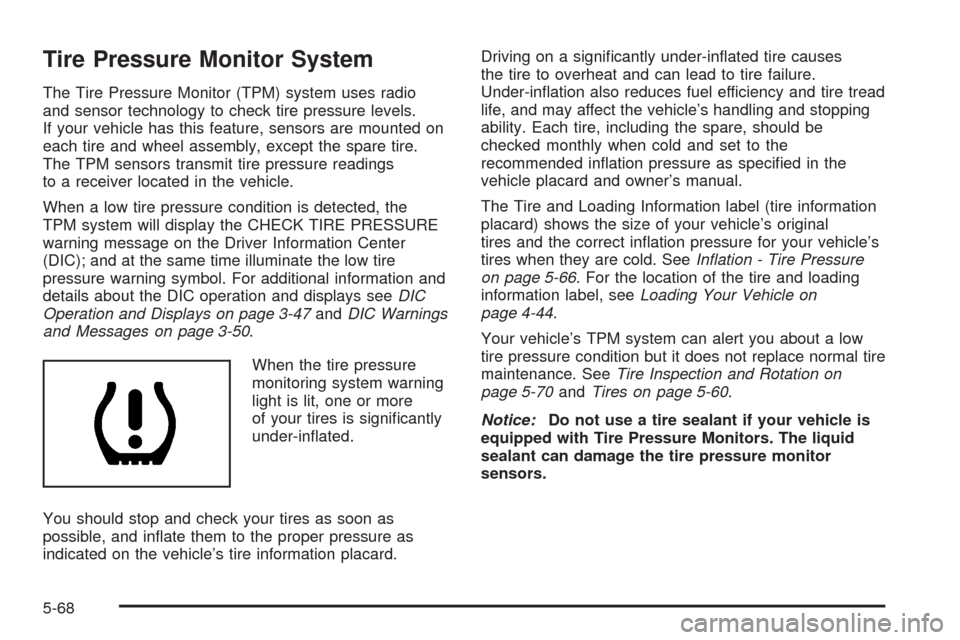
Tire Pressure Monitor System
The Tire Pressure Monitor (TPM) system uses radio
and sensor technology to check tire pressure levels.
If your vehicle has this feature, sensors are mounted on
each tire and wheel assembly, except the spare tire.
The TPM sensors transmit tire pressure readings
to a receiver located in the vehicle.
When a low tire pressure condition is detected, the
TPM system will display the CHECK TIRE PRESSURE
warning message on the Driver Information Center
(DIC); and at the same time illuminate the low tire
pressure warning symbol. For additional information and
details about the DIC operation and displays seeDIC
Operation and Displays on page 3-47andDIC Warnings
and Messages on page 3-50.
When the tire pressure
monitoring system warning
light is lit, one or more
of your tires is signi�cantly
under-in�ated.
You should stop and check your tires as soon as
possible, and in�ate them to the proper pressure as
indicated on the vehicle’s tire information placard.Driving on a signi�cantly under-in�ated tire causes
the tire to overheat and can lead to tire failure.
Under-in�ation also reduces fuel efficiency and tire tread
life, and may affect the vehicle’s handling and stopping
ability. Each tire, including the spare, should be
checked monthly when cold and set to the
recommended in�ation pressure as speci�ed in the
vehicle placard and owner’s manual.
The Tire and Loading Information label (tire information
placard) shows the size of your vehicle’s original
tires and the correct in�ation pressure for your vehicle’s
tires when they are cold. SeeIn�ation - Tire Pressure
on page 5-66. For the location of the tire and loading
information label, seeLoading Your Vehicle on
page 4-44.
Your vehicle’s TPM system can alert you about a low
tire pressure condition but it does not replace normal tire
maintenance. SeeTire Inspection and Rotation on
page 5-70andTires on page 5-60.
Notice:Do not use a tire sealant if your vehicle is
equipped with Tire Pressure Monitors. The liquid
sealant can damage the tire pressure monitor
sensors.
5-68
Page 367 of 460
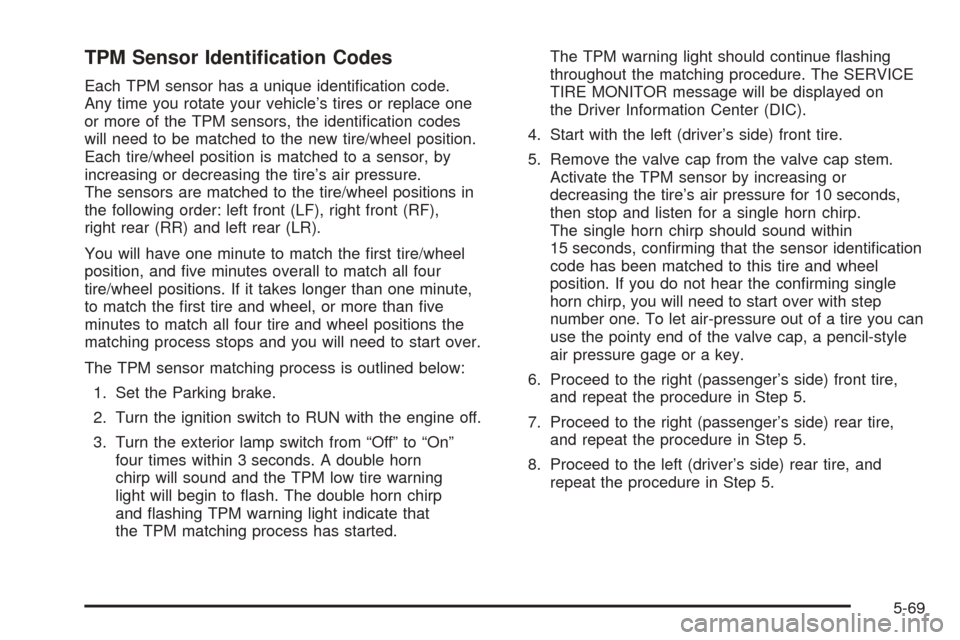
TPM Sensor Identi�cation Codes
Each TPM sensor has a unique identi�cation code.
Any time you rotate your vehicle’s tires or replace one
or more of the TPM sensors, the identi�cation codes
will need to be matched to the new tire/wheel position.
Each tire/wheel position is matched to a sensor, by
increasing or decreasing the tire’s air pressure.
The sensors are matched to the tire/wheel positions in
the following order: left front (LF), right front (RF),
right rear (RR) and left rear (LR).
You will have one minute to match the �rst tire/wheel
position, and �ve minutes overall to match all four
tire/wheel positions. If it takes longer than one minute,
to match the �rst tire and wheel, or more than �ve
minutes to match all four tire and wheel positions the
matching process stops and you will need to start over.
The TPM sensor matching process is outlined below:
1. Set the Parking brake.
2. Turn the ignition switch to RUN with the engine off.
3. Turn the exterior lamp switch from “Off” to “On”
four times within 3 seconds. A double horn
chirp will sound and the TPM low tire warning
light will begin to �ash. The double horn chirp
and �ashing TPM warning light indicate that
the TPM matching process has started.The TPM warning light should continue �ashing
throughout the matching procedure. The SERVICE
TIRE MONITOR message will be displayed on
the Driver Information Center (DIC).
4. Start with the left (driver’s side) front tire.
5. Remove the valve cap from the valve cap stem.
Activate the TPM sensor by increasing or
decreasing the tire’s air pressure for 10 seconds,
then stop and listen for a single horn chirp.
The single horn chirp should sound within
15 seconds, con�rming that the sensor identi�cation
code has been matched to this tire and wheel
position. If you do not hear the con�rming single
horn chirp, you will need to start over with step
number one. To let air-pressure out of a tire you can
use the pointy end of the valve cap, a pencil-style
air pressure gage or a key.
6. Proceed to the right (passenger’s side) front tire,
and repeat the procedure in Step 5.
7. Proceed to the right (passenger’s side) rear tire,
and repeat the procedure in Step 5.
8. Proceed to the left (driver’s side) rear tire, and
repeat the procedure in Step 5.
5-69
Page 368 of 460
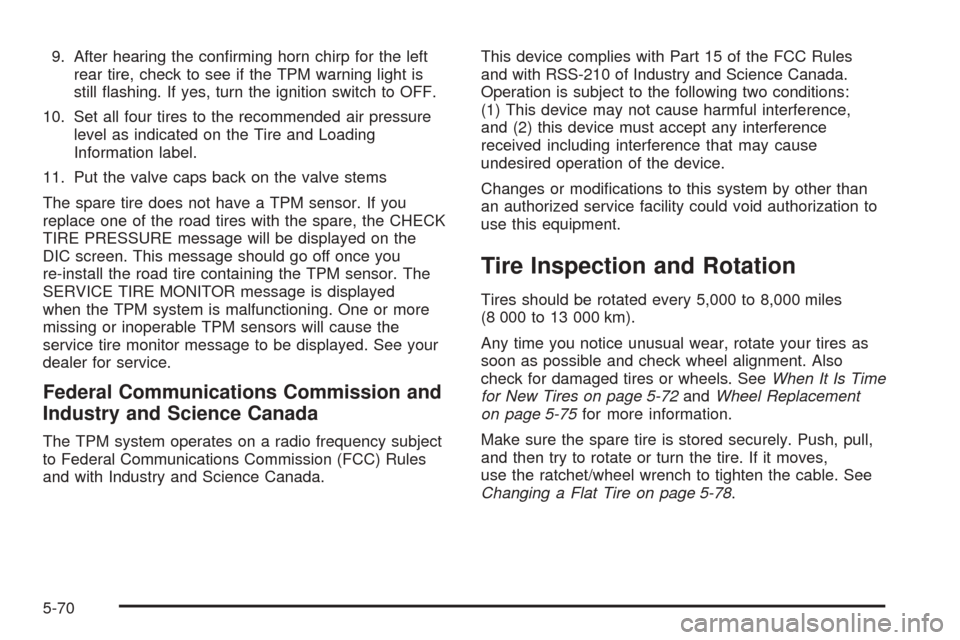
9. After hearing the con�rming horn chirp for the left
rear tire, check to see if the TPM warning light is
still �ashing. If yes, turn the ignition switch to OFF.
10. Set all four tires to the recommended air pressure
level as indicated on the Tire and Loading
Information label.
11. Put the valve caps back on the valve stems
The spare tire does not have a TPM sensor. If you
replace one of the road tires with the spare, the CHECK
TIRE PRESSURE message will be displayed on the
DIC screen. This message should go off once you
re-install the road tire containing the TPM sensor. The
SERVICE TIRE MONITOR message is displayed
when the TPM system is malfunctioning. One or more
missing or inoperable TPM sensors will cause the
service tire monitor message to be displayed. See your
dealer for service.
Federal Communications Commission and
Industry and Science Canada
The TPM system operates on a radio frequency subject
to Federal Communications Commission (FCC) Rules
and with Industry and Science Canada.This device complies with Part 15 of the FCC Rules
and with RSS-210 of Industry and Science Canada.
Operation is subject to the following two conditions:
(1) This device may not cause harmful interference,
and (2) this device must accept any interference
received including interference that may cause
undesired operation of the device.
Changes or modi�cations to this system by other than
an authorized service facility could void authorization to
use this equipment.
Tire Inspection and Rotation
Tires should be rotated every 5,000 to 8,000 miles
(8 000 to 13 000 km).
Any time you notice unusual wear, rotate your tires as
soon as possible and check wheel alignment. Also
check for damaged tires or wheels. SeeWhen It Is Time
for New Tires on page 5-72andWheel Replacement
on page 5-75for more information.
Make sure the spare tire is stored securely. Push, pull,
and then try to rotate or turn the tire. If it moves,
use the ratchet/wheel wrench to tighten the cable. See
Changing a Flat Tire on page 5-78.
5-70
Page 372 of 460
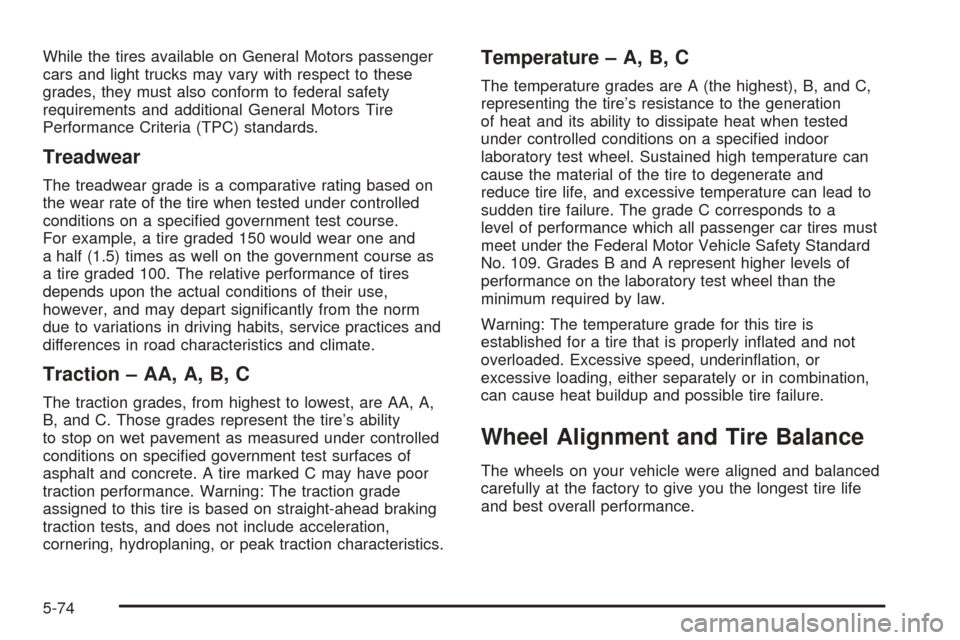
While the tires available on General Motors passenger
cars and light trucks may vary with respect to these
grades, they must also conform to federal safety
requirements and additional General Motors Tire
Performance Criteria (TPC) standards.
Treadwear
The treadwear grade is a comparative rating based on
the wear rate of the tire when tested under controlled
conditions on a speci�ed government test course.
For example, a tire graded 150 would wear one and
a half (1.5) times as well on the government course as
a tire graded 100. The relative performance of tires
depends upon the actual conditions of their use,
however, and may depart signi�cantly from the norm
due to variations in driving habits, service practices and
differences in road characteristics and climate.
Traction – AA, A, B, C
The traction grades, from highest to lowest, are AA, A,
B, and C. Those grades represent the tire’s ability
to stop on wet pavement as measured under controlled
conditions on speci�ed government test surfaces of
asphalt and concrete. A tire marked C may have poor
traction performance. Warning: The traction grade
assigned to this tire is based on straight-ahead braking
traction tests, and does not include acceleration,
cornering, hydroplaning, or peak traction characteristics.
Temperature – A, B, C
The temperature grades are A (the highest), B, and C,
representing the tire’s resistance to the generation
of heat and its ability to dissipate heat when tested
under controlled conditions on a speci�ed indoor
laboratory test wheel. Sustained high temperature can
cause the material of the tire to degenerate and
reduce tire life, and excessive temperature can lead to
sudden tire failure. The grade C corresponds to a
level of performance which all passenger car tires must
meet under the Federal Motor Vehicle Safety Standard
No. 109. Grades B and A represent higher levels of
performance on the laboratory test wheel than the
minimum required by law.
Warning: The temperature grade for this tire is
established for a tire that is properly in�ated and not
overloaded. Excessive speed, underin�ation, or
excessive loading, either separately or in combination,
can cause heat buildup and possible tire failure.
Wheel Alignment and Tire Balance
The wheels on your vehicle were aligned and balanced
carefully at the factory to give you the longest tire life
and best overall performance.
5-74
Page 447 of 460
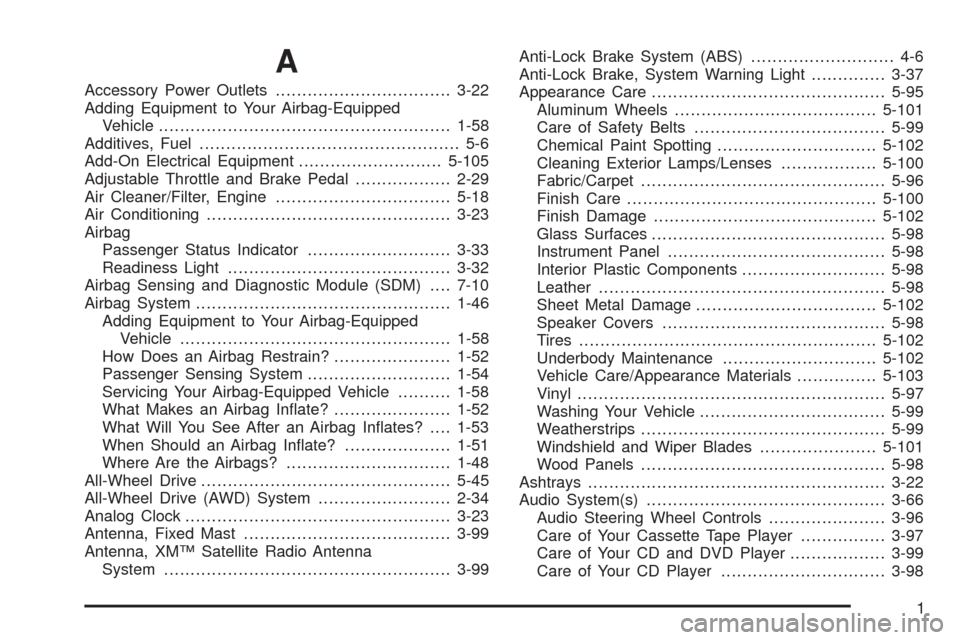
A
Accessory Power Outlets.................................3-22
Adding Equipment to Your Airbag-Equipped
Vehicle.......................................................1-58
Additives, Fuel................................................. 5-6
Add-On Electrical Equipment...........................5-105
Adjustable Throttle and Brake Pedal..................2-29
Air Cleaner/Filter, Engine.................................5-18
Air Conditioning..............................................3-23
Airbag
Passenger Status Indicator...........................3-33
Readiness Light..........................................3-32
Airbag Sensing and Diagnostic Module (SDM)....7-10
Airbag System................................................1-46
Adding Equipment to Your Airbag-Equipped
Vehicle...................................................1-58
How Does an Airbag Restrain?......................1-52
Passenger Sensing System...........................1-54
Servicing Your Airbag-Equipped Vehicle..........1-58
What Makes an Airbag In�ate?......................1-52
What Will You See After an Airbag In�ates?....1-53
When Should an Airbag In�ate?....................1-51
Where Are the Airbags?...............................1-48
All-Wheel Drive...............................................5-45
All-Wheel Drive (AWD) System.........................2-34
Analog Clock..................................................3-23
Antenna, Fixed Mast.......................................3-99
Antenna, XM™ Satellite Radio Antenna
System......................................................3-99Anti-Lock Brake System (ABS)........................... 4-6
Anti-Lock Brake, System Warning Light..............3-37
Appearance Care............................................5-95
Aluminum Wheels......................................5-101
Care of Safety Belts....................................5-99
Chemical Paint Spotting..............................5-102
Cleaning Exterior Lamps/Lenses..................5-100
Fabric/Carpet..............................................5-96
Finish Care...............................................5-100
Finish Damage..........................................5-102
Glass Surfaces............................................5-98
Instrument Panel.........................................5-98
Interior Plastic Components...........................5-98
Leather......................................................5-98
Sheet Metal Damage..................................5-102
Speaker Covers..........................................5-98
Tires........................................................5-102
Underbody Maintenance.............................5-102
Vehicle Care/Appearance Materials...............5-103
Vinyl..........................................................5-97
Washing Your Vehicle...................................5-99
Weatherstrips..............................................5-99
Windshield and Wiper Blades......................5-101
Wood Panels..............................................5-98
Ashtrays........................................................3-22
Audio System(s).............................................3-66
Audio Steering Wheel Controls......................3-96
Care of Your Cassette Tape Player................3-97
Care of Your CD and DVD Player..................3-99
Care of Your CD Player...............................3-98
1
Page 448 of 460
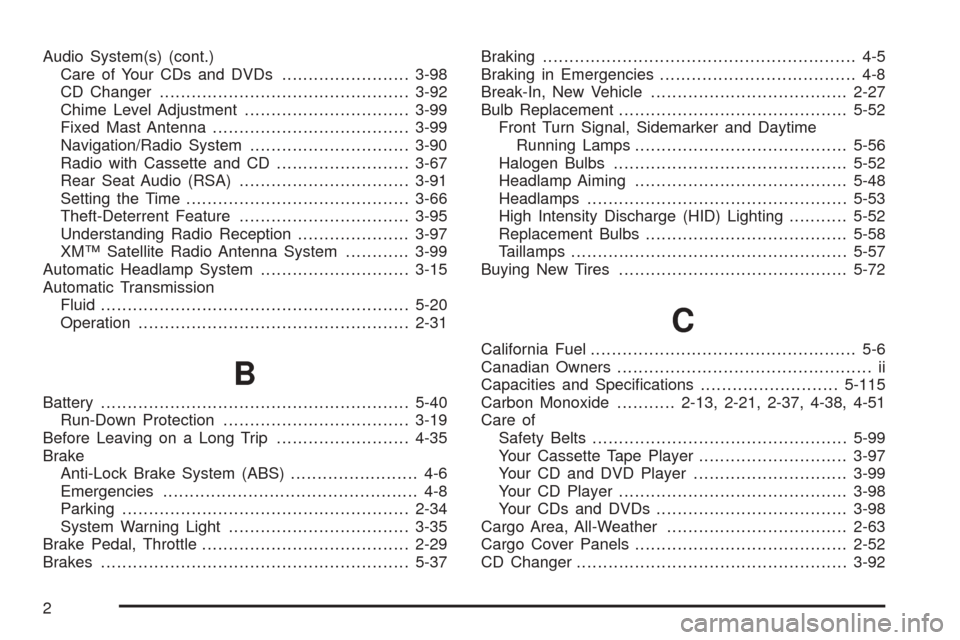
Audio System(s) (cont.)
Care of Your CDs and DVDs........................3-98
CD Changer...............................................3-92
Chime Level Adjustment...............................3-99
Fixed Mast Antenna.....................................3-99
Navigation/Radio System..............................3-90
Radio with Cassette and CD.........................3-67
Rear Seat Audio (RSA)................................3-91
Setting the Time..........................................3-66
Theft-Deterrent Feature................................3-95
Understanding Radio Reception.....................3-97
XM™ Satellite Radio Antenna System............3-99
Automatic Headlamp System............................3-15
Automatic Transmission
Fluid..........................................................5-20
Operation...................................................2-31
B
Battery..........................................................5-40
Run-Down Protection...................................3-19
Before Leaving on a Long Trip.........................4-35
Brake
Anti-Lock Brake System (ABS)........................ 4-6
Emergencies................................................ 4-8
Parking......................................................2-34
System Warning Light..................................3-35
Brake Pedal, Throttle.......................................2-29
Brakes..........................................................5-37Braking........................................................... 4-5
Braking in Emergencies..................................... 4-8
Break-In, New Vehicle.....................................2-27
Bulb Replacement...........................................5-52
Front Turn Signal, Sidemarker and Daytime
Running Lamps........................................5-56
Halogen Bulbs............................................5-52
Headlamp Aiming........................................5-48
Headlamps.................................................5-53
High Intensity Discharge (HID) Lighting...........5-52
Replacement Bulbs......................................5-58
Taillamps....................................................5-57
Buying New Tires...........................................5-72
C
California Fuel.................................................. 5-6
Canadian Owners................................................ ii
Capacities and Speci�cations..........................5-115
Carbon Monoxide...........2-13, 2-21, 2-37, 4-38, 4-51
Care of
Safety Belts................................................5-99
Your Cassette Tape Player............................3-97
Your CD and DVD Player.............................3-99
Your CD Player...........................................3-98
Your CDs and DVDs....................................3-98
Cargo Area, All-Weather..................................2-63
Cargo Cover Panels........................................2-52
CD Changer...................................................3-92
2
Page 451 of 460
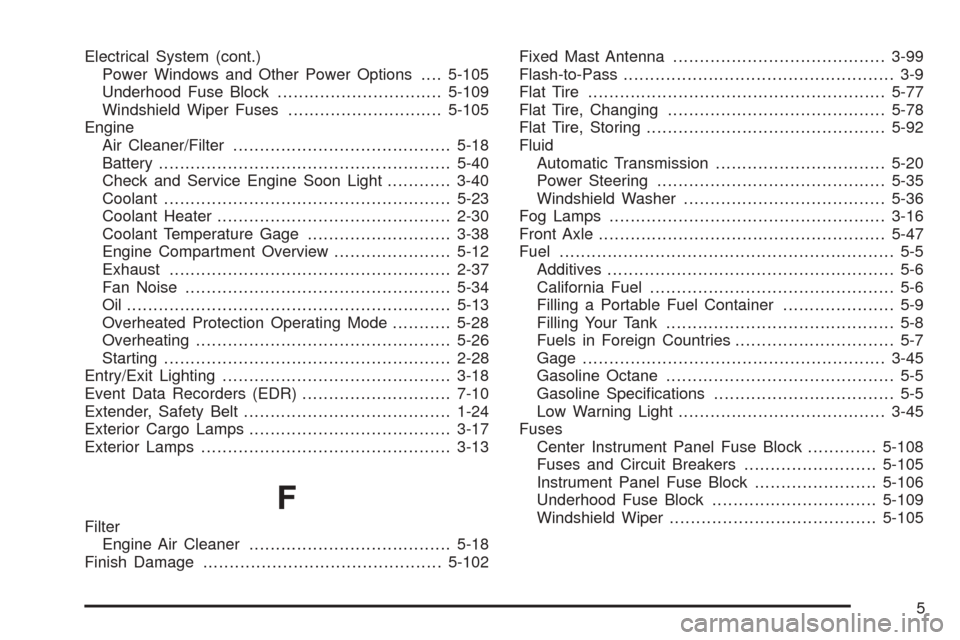
Electrical System (cont.)
Power Windows and Other Power Options....5-105
Underhood Fuse Block...............................5-109
Windshield Wiper Fuses.............................5-105
Engine
Air Cleaner/Filter.........................................5-18
Battery.......................................................5-40
Check and Service Engine Soon Light............3-40
Coolant......................................................5-23
Coolant Heater............................................2-30
Coolant Temperature Gage...........................3-38
Engine Compartment Overview......................5-12
Exhaust.....................................................2-37
Fan Noise..................................................5-34
Oil .............................................................5-13
Overheated Protection Operating Mode...........5-28
Overheating................................................5-26
Starting......................................................2-28
Entry/Exit Lighting...........................................3-18
Event Data Recorders (EDR)............................7-10
Extender, Safety Belt.......................................1-24
Exterior Cargo Lamps......................................3-17
Exterior Lamps...............................................3-13
F
Filter
Engine Air Cleaner......................................5-18
Finish Damage.............................................5-102Fixed Mast Antenna........................................3-99
Flash-to-Pass................................................... 3-9
Flat Tire........................................................5-77
Flat Tire, Changing.........................................5-78
Flat Tire, Storing.............................................5-92
Fluid
Automatic Transmission................................5-20
Power Steering...........................................5-35
Windshield Washer......................................5-36
Fog Lamps....................................................3-16
Front Axle......................................................5-47
Fuel............................................................... 5-5
Additives...................................................... 5-6
California Fuel.............................................. 5-6
Filling a Portable Fuel Container..................... 5-9
Filling Your Tank........................................... 5-8
Fuels in Foreign Countries.............................. 5-7
Gage.........................................................3-45
Gasoline Octane........................................... 5-5
Gasoline Speci�cations.................................. 5-5
Low Warning Light.......................................3-45
Fuses
Center Instrument Panel Fuse Block.............5-108
Fuses and Circuit Breakers.........................5-105
Instrument Panel Fuse Block.......................5-106
Underhood Fuse Block...............................5-109
Windshield Wiper.......................................5-105
5
Page 452 of 460
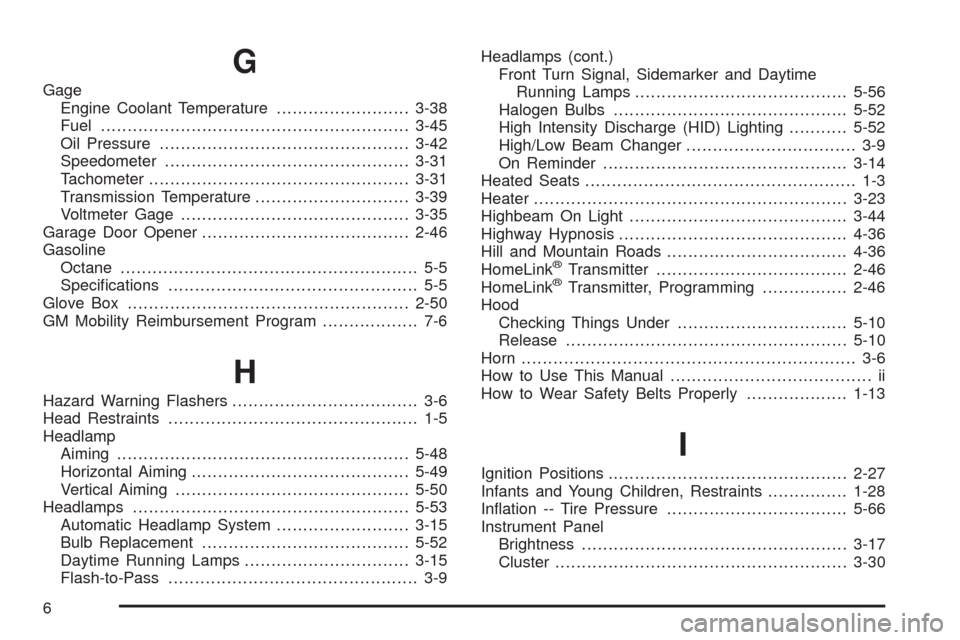
G
Gage
Engine Coolant Temperature.........................3-38
Fuel..........................................................3-45
Oil Pressure...............................................3-42
Speedometer..............................................3-31
Tachometer.................................................3-31
Transmission Temperature.............................3-39
Voltmeter Gage...........................................3-35
Garage Door Opener.......................................2-46
Gasoline
Octane........................................................ 5-5
Speci�cations............................................... 5-5
Glove Box.....................................................2-50
GM Mobility Reimbursement Program.................. 7-6
H
Hazard Warning Flashers................................... 3-6
Head Restraints............................................... 1-5
Headlamp
Aiming.......................................................5-48
Horizontal Aiming.........................................5-49
Vertical Aiming............................................5-50
Headlamps....................................................5-53
Automatic Headlamp System.........................3-15
Bulb Replacement.......................................5-52
Daytime Running Lamps...............................3-15
Flash-to-Pass............................................... 3-9Headlamps (cont.)
Front Turn Signal, Sidemarker and Daytime
Running Lamps........................................5-56
Halogen Bulbs............................................5-52
High Intensity Discharge (HID) Lighting...........5-52
High/Low Beam Changer................................ 3-9
On Reminder..............................................3-14
Heated Seats................................................... 1-3
Heater...........................................................3-23
Highbeam On Light.........................................3-44
Highway Hypnosis...........................................4-36
Hill and Mountain Roads..................................4-36
HomeLink
®Transmitter....................................2-46
HomeLink®Transmitter, Programming................2-46
Hood
Checking Things Under................................5-10
Release.....................................................5-10
Horn............................................................... 3-6
How to Use This Manual...................................... ii
How to Wear Safety Belts Properly...................1-13
I
Ignition Positions.............................................2-27
Infants and Young Children, Restraints...............1-28
In�ation -- Tire Pressure..................................5-66
Instrument Panel
Brightness..................................................3-17
Cluster.......................................................3-30
6
Page 453 of 460
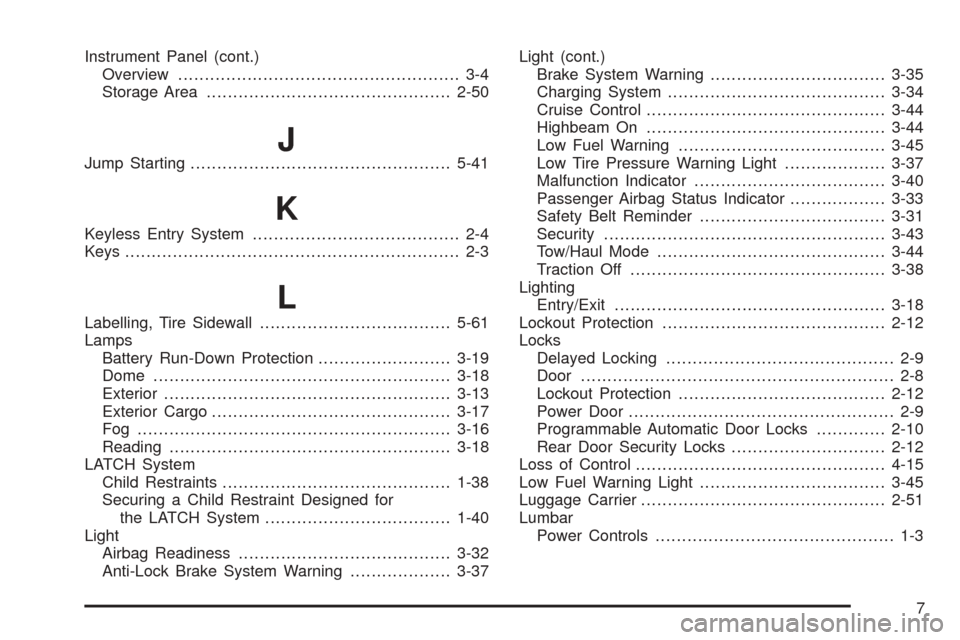
Instrument Panel (cont.)
Overview..................................................... 3-4
Storage Area..............................................2-50
JJump Starting.................................................5-41
K
Keyless Entry System....................................... 2-4
Keys............................................................... 2-3
L
Labelling, Tire Sidewall....................................5-61
Lamps
Battery Run-Down Protection.........................3-19
Dome........................................................3-18
Exterior......................................................3-13
Exterior Cargo.............................................3-17
Fog ...........................................................3-16
Reading.....................................................3-18
LATCH System
Child Restraints...........................................1-38
Securing a Child Restraint Designed for
the LATCH System...................................1-40
Light
Airbag Readiness........................................3-32
Anti-Lock Brake System Warning...................3-37Light (cont.)
Brake System Warning.................................3-35
Charging System.........................................3-34
Cruise Control.............................................3-44
Highbeam On.............................................3-44
Low Fuel Warning.......................................3-45
Low Tire Pressure Warning Light...................3-37
Malfunction Indicator....................................3-40
Passenger Airbag Status Indicator..................3-33
Safety Belt Reminder...................................3-31
Security.....................................................3-43
Tow/Haul Mode...........................................3-44
Traction Off................................................3-38
Lighting
Entry/Exit...................................................3-18
Lockout Protection..........................................2-12
Locks
Delayed Locking........................................... 2-9
Door........................................................... 2-8
Lockout Protection.......................................2-12
Power Door.................................................. 2-9
Programmable Automatic Door Locks.............2-10
Rear Door Security Locks.............................2-12
Loss of Control...............................................4-15
Low Fuel Warning Light...................................3-45
Luggage Carrier..............................................2-51
Lumbar
Power Controls............................................. 1-3
7